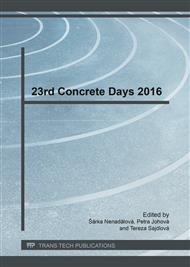[1]
Zsutty, T. (1968) Beam shear strength prediction by analysis of existing data. ACI Journal V. 65(11): pp.943-951.
Google Scholar
[2]
Muttoni A., Schwartz, J. (1991) Behaviour of beams and punching in slabs without shear reinforcement, IABSE Colloquium, Vol. 62, Zurich, Switzerland, 1991, pp.703-708.
Google Scholar
[3]
Regan P.E. (2000): Shear Reinforcement of Flat Slabs, in Proceedings of International Workshop on Punching Shear Capacity of RC Slabs, TRITA/BKN, Bulletin 57, 2000, pp.97-107.
DOI: 10.14359/14937
Google Scholar
[4]
Muttoni A., Fernández Ruiz M. (2008) Shear strength of members without transverse reinforcement as function of critical shear crack width, ACI Structural Journal, V. 105, No 2, 2008, pp.163-172.
DOI: 10.14359/19731
Google Scholar
[5]
EN1992-1-1 Design of Concrete Structures, Part 1-1 General Rules and Rules for Buildings, May (2004).
Google Scholar
[6]
Fédération Internationale du Béton (fib), Model Code 2010 - Final draft, Vol. 1, Fédération internationale du béton, Bulletin 65, Lausanne, Switzerland, 2012, Vol. 2.
DOI: 10.35789/fib.bull.0104
Google Scholar
[7]
Muttoni, A., Fernández Ruiz, M., (2012) The levels-of-approximation approach in MC 2010: applications to punching shear provisions, Structural Concrete, Ernst & Sohn, Germany, Vol. 13, No. 1, 2012, pp.32-41.
DOI: 10.1002/suco.201100032
Google Scholar
[8]
Siburg C., Hausler F., Hegger,J. (2012) Flat slab punching design according to German annex of Eurocode 2, Bauinginieur, Volume 87, May 2012, pp.216-225.
Google Scholar
[9]
Hegger J., Häusler F., Ricker M. (2008) Critical review of the punching shear provisions according to Eurocode 2 (in German: Zur Durchstanzbemessung von Flachdecken nach Eurocode 2), Beton- und Stahlbetonbau, Vol. 103, No. 2, 2008, pp.93-102.
DOI: 10.1002/best.200700596
Google Scholar
[10]
Einpaul,J., Bujnak,J., Ruiz,M., and Muttoni,A. (2016) Study on influence of column size and slab slenderness on punching strength, ACI Structural Journal, V. 113, January-February 2016, pp.135-145.
DOI: 10.14359/51687945
Google Scholar
[11]
Hegger J., Siburg C., Kueres D. (2016) Proposal for punching shear design of flat slabs and column bases based on Eurocode 2, RWTH Aachen University, Germany, Presentation from CEN TC250/SC2/WG1/TG4 meeting in Copenhagen, 28. -29. January (2016).
DOI: 10.1016/j.engstruct.2016.12.064
Google Scholar
[12]
Ruiz M.F. - Muttoni,A. (2009) Application of Critical Shear Crack Theory to Punching of RC Slabs with Transverse Reinforcement, ACI Structural Journal V. 106 No. 4, July – August 2009, pp.485-494.
DOI: 10.14359/56614
Google Scholar
[13]
Feix,J. - Hausler,F. - Walkner,R. (2011): Necessary Amendments to the Rules for Punching Design According to EN 1992-1-1, in Proceedings of Workshop Design of Concrete Structures and Bridges using Eurocodes, Bratislava 2011, pp.21-27.
Google Scholar
[14]
Bujnak,J. - Gavura,S. (2012).
Google Scholar
[15]
Lips, S.; Fernández Ruiz, M.; and Muttoni, A. (2012) Experimental Investigation on Punching Strength and Deformation Capacity of Shear- Reinforced Slabs, ACI Structural Journal, V. 109, No. 6, Nov. -Dec. 2012, pp.889-900.
DOI: 10.14359/51684132
Google Scholar
[16]
Muttoni, A., Ruiz, F. (2015) Proposal for punching shear provisions based on CSCT, Presentation from CEN TC250/SC2/WG1/TG4 meeting in Florence, 12. -13. March (2015).
Google Scholar


